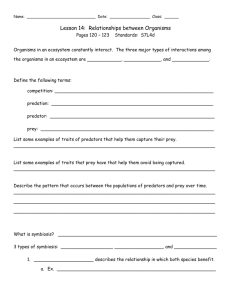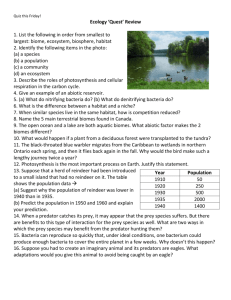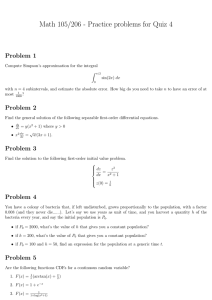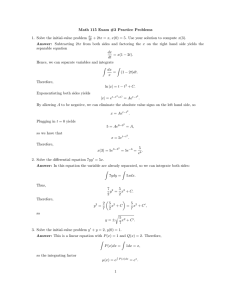Math 115 Exam #3 Solutions 1. Solve the initial-value problem
advertisement
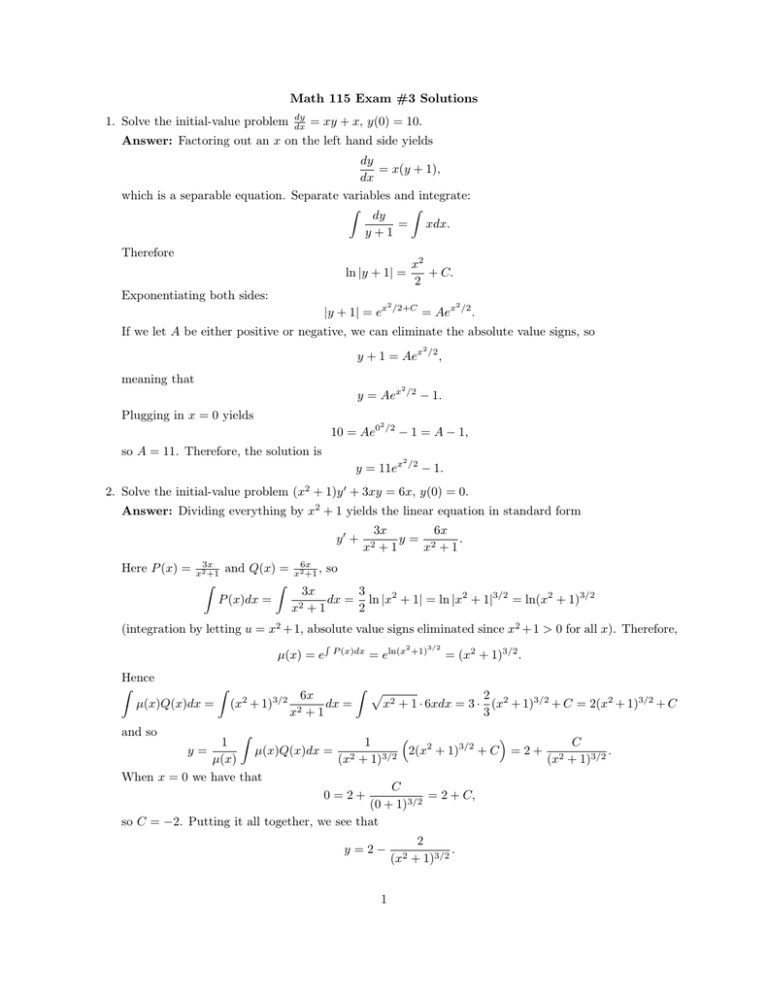
Math 115 Exam #3 Solutions 1. Solve the initial-value problem dy dx = xy + x, y(0) = 10. Answer: Factoring out an x on the left hand side yields dy = x(y + 1), dx which is a separable equation. Separate variables and integrate: Z Z dy = xdx. y+1 Therefore x2 + C. 2 ln |y + 1| = Exponentiating both sides: |y + 1| = ex 2 /2+C 2 = Aex /2 . If we let A be either positive or negative, we can eliminate the absolute value signs, so y + 1 = Aex 2 /2 , meaning that y = Aex 2 /2 − 1. Plugging in x = 0 yields 2 10 = Ae0 /2 − 1 = A − 1, so A = 11. Therefore, the solution is 2 y = 11ex /2 − 1. 0 2 2. Solve the initial-value problem (x + 1)y + 3xy = 6x, y(0) = 0. Answer: Dividing everything by x2 + 1 yields the linear equation in standard form y0 + Here P (x) = 3x x2 +1 Z and Q(x) = Z P (x)dx = 6x x2 +1 , 6x 3x y= 2 . x2 + 1 x +1 so 3x 3 dx = ln |x2 + 1| = ln |x2 + 1|3/2 = ln(x2 + 1)3/2 x2 + 1 2 (integration by letting u = x2 + 1, absolute value signs eliminated since x2 + 1 > 0 for all x). Therefore, µ(x) = e Hence Z Z µ(x)Q(x)dx = (x2 + 1)3/2 R P (x)dx 6x dx = x2 + 1 = eln(x Z p 2 +1)3/2 = (x2 + 1)3/2 . 2 x2 + 1 · 6xdx = 3 · (x2 + 1)3/2 + C = 2(x2 + 1)3/2 + C 3 and so Z 1 C 1 2 3/2 y= 2(x + 1) + C =2+ 2 µ(x)Q(x)dx = 2 . 3/2 µ(x) (x + 1) (x + 1)3/2 When x = 0 we have that C 0=2+ = 2 + C, (0 + 1)3/2 so C = −2. Putting it all together, we see that y =2− 1 2 . (x2 + 1)3/2 dy 3. Solve the initial-value problem x4 dx + 3x3 y = xex , x > 0, y(1) = −1. Answer: Dividing everything by x4 yields the following linear equation in standard form: 3 ex dy + y = 3. dx x x Here P (x) = 3 x x and Q(x) = xe 3 , so Z Z 3 P (x)dx = dx = 3 ln |x| = ln |x|3 = ln(x3 ) x since x > 0. Therefore, µ(x) = e R 3 P (x)dx = eln(x x Z ) = x3 . In turn, this means that Z Z µ(x)Q(x)dx = so 1 y= µ(x) x 3e x3 dx = Z µ(x)Q(x)dx = ex dx = ex + C, 1 x ex C (e + C) = + 3. 3 3 x x x Plugging in x = 1, we see that −1 = e1 C + 3 = e + C, 3 1 1 so C = −1 − e, and so y= ex 1+e − 3 . 3 x x 4. A super-fast-growing bacteria reproduces so quickly that the rate of production of new bacteria is proportional to the square of the number already present. If a sample starts with 100 bacteria, and after 3 hours there are 200 bacteria, how long (after the starting time) will it take until there are (theoretically) an infinite number of bacteria? Answer: Let P (t) be the population of bacteria after t hours. Then the above says that dP = kP 2 . dt This is a separable equation, so we can separate variables and integrate: Z Z dP = kdt. P2 Therefore, − 1 = kt + C, P meaning that P =− 1 . kt + C Plugging in t = 0 gives 100 = − 1 1 =− , k(0) + C C 1 so C = − 100 . In turn, plugging in t = 3 yields 200 = − 1 k(3) − 2 1 100 =− 1 1 . 3k − 100 Hence, 3k − 1 1 =− , 100 200 meaning that 3k = − and k = 1 600 . 1 1 1 + = 200 100 200 Therefore, P (t) = − t 600 1 − 1 100 =− 600 . t−6 The population will theoretically be infinite when the denominator is zero, i.e. after 6 hours. 5. In the following predator-prey system, determine which of the variables, x or y, represents the prey population and which represents the predator population. Is the growth of the prey restricted just by the predators or by other factors as well? Explain. dx = 0.2x − 0.0002x2 − 0.006xy dt dy = −0.015y + 0.00008xy. dt Answer: In this system, an increase in the population of y causes the rate of growth of x to decrease, whereas an increase in the population of x causes the rate of growth of y to increase. Thus, the behavior of the system is consistent with x being the prey and y being the predator. The growth of the prey, x, is restricted by the presence of the predators, y, but is also restricted by an 2 additional factor, indicated in the expression for dx dt by the term −0.0002x . Notice that, as long as x 2 isn’t too big, the term 0.2x dominates −0.0002x . However, as x gets very large, eventually −0.0002x2 will dominate 0.2x. In other words, although for relatively small x increases in x cause an increase in dx dt , the rate of growth of x, the rate of growth will decline as x gets bigger and bigger. Thus, a reasonable guess is that the additional factor restricting the growth of x is overcrowding. In fact, we can re-write the first equation as 1 dx = 0.2x 1 − x − 0.006xy, dt 1000 which is the type of equation we derived when we assumed that, in the absence of predators, the prey population experienced logistic rather than exponential growth. Thus, the guess that the extra factor has to do with overcrowding (or, equivalently, carrying capacity), was correct. 3
